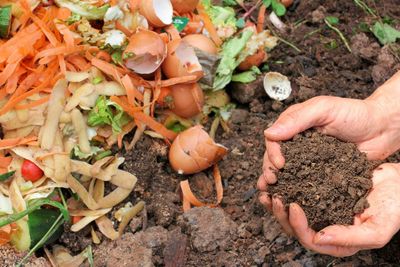Composting Basics
Numerous benefits are associated with the use of compost:
It can enhance the soil, building up the structure and texture. It increases airflow and water retention. Compost also stabilizes pH levels and supports essential bacteria. Compost allows plants to effectively use nutrients for achieving healthier growth as well.
In addition, the organic matter found in compost encourages earthworms, which also help aerate the soil. Other benefits include erosion control and the reduction of soil-borne diseases.
How Does Composting Work?
Compost is made up of organic materials that break down in the soil, enriching its structure and adding essential nutrients. To understand the composting process, it helps to look at the natural decomposition process found in nature. For instance, wooded areas are filled with organic materials—trees, leaves, etc. Over time these materials slowly decompose, or break down, with the help of micro-organisms and earthworms. Once the materials have decomposed, they turn into humus, an essential element in the production of rich, fertile soil that is also responsible for producing healthy plants. This process is similar to garden composting. Once decomposition has taken place in the compost pile, the result should be similar to that of humus with a dark, crumbly, soil-like material.
Make Your Own Compost
While composting instructions vary, most share the same basic principles. Generally, passive composting methods are most often used. This method involves small piles of compost contained in a bin, enclosure, or compost containers. These, too, vary with sizes ranging between 5 to 7 feet (1.5 to 2 m.) around and 3 to 4 feet high (0.9-1.2 m.) However, a more manageable size, especially for smaller gardens, may be no larger than 3 by 3 feet (0.9 by 0.9 m.) Nonetheless, it’s easy to tailor your composting system to meet your specific needs. Most compost is made up of organic materials like leaves, garden plants, newspaper, straw, grass clippings, manure, and kitchen scraps. Kitchen waste should include materials like vegetables and fruit peeling, eggshells, coffee grounds, etc. Meat, fat, and bone products should never be added to the compost pile, as they can introduce harmful parasites and attract animals. You should alternate layers of green and brown materials. Green items include grass clippings and kitchen scraps, adding nitrogen to the compost. Brown materials add carbon to compost containers and consist of things like leaves, newspaper, and small woody materials. Moisture and adequate air circulation are vital for composting. Therefore, they should be kept wet but not soggy. In addition, compost should be frequently turned with a garden fork to aid in aeration as well as speed up the decomposition process. Depending on the materials used and size of the compost pile, decomposition can take anywhere from weeks or months to a year.
